Cherry Blossoms|桜
Summary

Without a doubt the most famous seasons to enjoy Kyoto are spring and fall, and when it comes to spring, the reason is obviously cherry blossoms. Sakura has long been lauded in Japanese culture, arts, verse, and song as a symbol of fragile beauty, a flower that blooms in lovely shades of pinks and whites only to fall and vanish soon after. It is exactly because of that short lifespan that the cherry blossoms are appreciated as much as they are: these flowers we can only see for a week or so before they begin to fade and then wait until the next season to see them again.
Sakura are found everywhere in Kyoto, and many shrines and temples hold special late openings, illuminations, or events that coincide with the season and allow visitors to experience the sight of the short-lived cherry blossoms alongside the historic buildings that have seen hundreds of springs come and go. It can be difficult to give the exact timing for the beginning and end of the cherry blossom season because it is directly influenced by the weather that year, but in Kyoto they tend to begin blooming in late March and start falling by the middle of April. It varies with each place and each species of sakura, however, so online sites often chart the expected course as well as the current conditions.
For visitors who need help in English, the Tourist Information Center keeps an extensive chart in their Kyoto Station office that displays the conditions of the cherry blossoms at a variety of locations. For those who want to experience the passing beauty of Japanese sakura, you needn’t look much further than Kyoto City in April!
Heian Jingū

Heian Shrine is home to the gorgeous Shin'en Garden, a strolling pond garden located behind the shrine's main hall. With an abundance of yaebeni weeping cherry trees, you'll be able to see fluffy strands of pink blossoms draped over the shrine's unusual green tile roofs before you even enter the garden. Designed by the famous Ogawa Jihei (Ueji), the garden features an exquisite mix of Eastern and Western styles, with a beautiful pond and the classic Taihei-kaku (Bridge of Peace).
Admission for Shin'en Garden: ¥600
Hirano Shrine

Hirano Shrine's garden is made up entirely of cherry trees, which makes it a must-see in the spring season. Within a fenced garden area tall, slender sakura weep over strolling paths, and within the main shrine sanctuary area is a variety of the more rare types of cherry blossoms, such as many-petaled yaezakura (with doubled flowers), and uncommon colors like greenish white. Over sixty species of sakura and 400 trees can be seen at Hirano Shrine both day and night, and visitors are able take a seat and enjoy hot meals or cool drinks at the various food stalls that pop up beneath the cherry trees.
Haradani-en
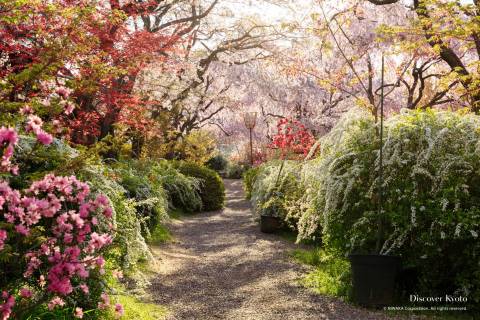
Haradani-en is a privately owned garden famous for its breathtaking cherry blossoms. There are over 400 sakura trees at Haradani-en representing more than 20 different species. Unlike the more structured layout one expects from traditional Japanese gardens, Haradani-en possesses a more natural, wild feel reminiscent of an English cottage garden. Here you can purchase a special bentō lunch box to enjoy amongst the flowers, and later swing by the popular Kinkaku-ji on your way home!
Sewari-tei

Journey southwest of Kyoto to find the Sewari-tei riverbank, popular among locals but as of yet unknown to many tourists. Here, a 1.4 kilometer long path is lined on both sides with tall, bountiful cherry trees. The sakura tunnel effect at this park in Yawata city is absolutely gorgeous, and you can even have a picnic underneath the branches heavy with flowers. In a nearby area vendors sell tasty snacks and souvenirs, and depending on the day you might see some entertainment during April's cherry blossom season. Because this place is as beautiful as it is, make sure you get there early if you want a prime spot to lay your blanket down!
Taizō-in

Taizō-in is one of the oldest sub-temples in Myōshin-ji, host to Zen experiences such as calligraphy, zazen meditation, tea ceremony, and shōjin ryōri vegetarian cuisine. It is most famous for its gorgeous weeping cherry blossom in spring, with tendrils reaching down nearly to the ground. Taizō-in’s gardens offer a variety of other seasonal flowers as well, such as gardenia, iris, wisteria, and lotus. The Yokō-en garden with its waterfall, pond and skillful layers of grass and flowers makes a lovely and deceptively large sight to take a seat in front of and enjoy.
Tō-ji

When arriving in Kyoto by bullet train you may catch sight of a pagoda rising up out of the city near the station – and that pagoda belongs to Tō-ji, a UNESCO World Heritage Site. Home to a considerable collection of impressive Buddhist statuary, this temple is also known for a garden that is laid out in front of its five-storied pagoda. Though the garden contains about 200 sakura trees, the crown jewel is a giant, double-flowered crimson weeping sakura tree that has earned the name Peerless Cherry (Fujizakura).
In addition to its usual daytime hours, Tō-ji also hosts an annual cherry blossom light-up so that visitors can enjoy the garden after dark.
Kamigamo Shrine

Kamigamo Shrine is one of Kyoto’s UNESCO World Heritage Sites and possesses a rich history as one of the oldest Shinto shrines in the city. The shrine is composed of swathes of nature and expanses of pale gravel, with the buildings contrasting yet somehow harmonized in natural wood against the brilliant vermilion of its gates and fences. Beside the long sandō path that connects the torii entrance gate to the main shrine area are multiple weeping cherry trees supported by bamboo trellises and poles, and come spring the branches grow heavy with fluffy petals. Throughout the entire grounds are cherry trees here and there in various shades between pink and white, adding spots of color to the storied shrine.
Kyoto Imperial Palace Park
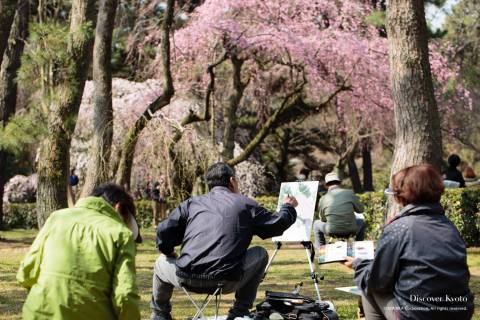
Around the august Gosho is the Gyoen (Imperial Palace Park), spread over approximately 4 square km. Once an area behind high walls where the imperial court resided, when the emperor moved to Tokyo the nobles' manors were dismantled and the resulting land was opened to the public. Filled with seasonal flowers as well as lush swathes of grass and pine, this park is a favorite for locals to stroll and picnic in. During cherry blossom season the park bursts into pink bloom, particularly at the former site of the Konoe residence in the north-eastern section. Considering its central location and free entry, the Gyoen makes a convenient stop for sakura viewing.
Nijō-jō

There are about 400 sakura trees of around 50 varieties at Nijō Castle. The majority of the sakura were planted from late 1955 until early 1965, and now they grace the multiple gardens that can be found surrounding the castle's inner keep.
Nijō Castle is one of the most famous places for people to visit during the season, partly because it also holds a light-up event. Viewing cherry blossoms during the day is gorgeous as it is, but stopping by at night to see them illuminated in artful ways provides a whole new way to enjoy the flowers.
Philosopher's Path
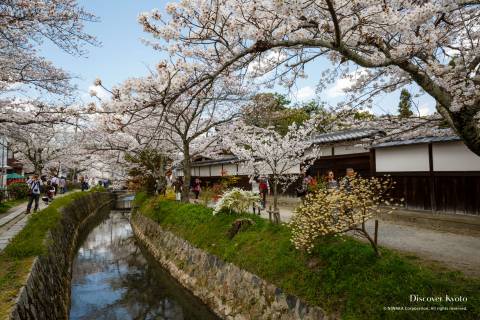
One of the most well-known areas in Kyoto to view flowers that isn't a shrine or temple is the Philosopher's Path (Tetsugaku no Michi). Stretching from Eikan-dō temple to Ginkaku-ji temple in the eastern Higashiyama area, the Philosopher's Path is a quaint street along a river that also passes by Ōtoyo Shrine, Anraku-ji temple, Hōnen-in temple, and several local teahouses and shops. Almost entirely lined with cherry blossoms, this usually quiet area becomes a bustling thoroughfare come sakura season and is a popular site for photo shoots and sightseeing alike.
Okazaki Canal

During Kyoto's sakura season the Okazaki area around the famous Heian Shrine bursts into bloom. Of particular interest to visitors is the Biwako Canal that forms a sort of moat around the area, bringing water in to Kyoto from the neighboring Shiga's Lake Biwa. This canal is lined with cherry blossoms and features a charming vermilion bridge near the shrine's large torii gate, making for a lovely photo op. This area is also lit up at night to allow visitors to enjoy the cherry blossoms even longer, and for those interested in getting a different view there are jikkokubune (traditional boats) that offer a 25 minute long scenic ride both day and night. Take a boat ride and enjoy the waters of Okazaki's canal combined with the spring charm of cherry blossoms.
Maruyama Park

One of the most popular public parks in Kyoto, as well as the oldest, is Maruyama Park. With an area of 86,000 square meters containing 800 cherry trees, the park contains a small pond and bridge as well as sprawling lawn and trees. It also has Japanese restaurants and a few small food stalls that increase in number during sakura season. The main attraction of the park is the weeping cherry blossom tree in the center that is lit up at nightfall, as it stands over 40 ft (12 meters) tall and is more than 80 years old, grown from a parent tree over 200 years old.
Shirakawa Street
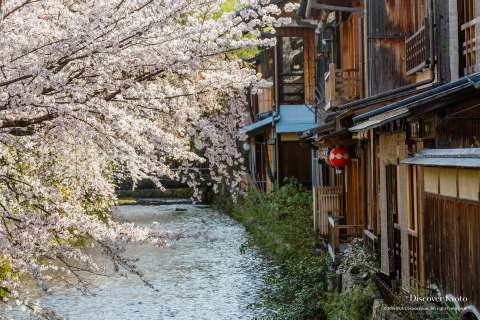
A scenic street in the heart of the Gion area, Shirakawa-dōri lies alongside the Shirakawa river and is flanked by willows on one side and sakura cherry trees on the other. The buildings that line the canal are high-class restaurants, inns, and teahouses that offer gorgeous riverside dining and Kyoto cuisine. This classical street is exceedingly popular for cherry blossom viewing in April thanks not only to the beautiful flowers, but also to the reputation of the Gion geisha districts for those hoping to catch a glimpse of a geiko or maiko.
Kōdai-ji

Kōdai-ji is a great place to see in cherry blossom season, with the added bonus of being able to visit both during the day and at nighttime. This temple holds a light-up in spring that allows you to enjoy illuminated sakura and a light show in the Hōjō garden if you're inclined to visit after dark. No matter what time you visit though, you can't miss the Hōjō's famous weeping cherry tree. Though this is the most well-known, there are also other sakura trees scattered about the temple grounds.
Ninna-ji

Ninna-ji temple is home to some very special sakura (cherry blossom) trees. Not only do these omuro sakura bloom much later than your average sakura, but they are also much shorter in height. The cherry trees usually start blooming in March in Kyoto, but the rare omuro sakura often come into full bloom in mid-April. This variety of trees only grows to around two meters in height, so walking through the grove ends up feeling like you’re wading through cherry blossom clouds. The beauty of these dwarf cherry trees has been admired since the Edo period, and many poems have been written about it throughout the ages.
Ryōan-ji

Ryōan-ji is famous for its Zen rock garden, but did you know that it is also a charming place to visit for sakura? A single cherry tree drapes over the distinctive earthen wall surrounding the famous Zen garden, but if you go beyond that well-known spot and take to the paths that wind around the temple's pond, you'll be able to enjoy a more natural-looking scenery with cherry blossoms along the way and around the pond itself, which was used for pleasure boating back when the property was a noble's villa.
Tenryū-ji
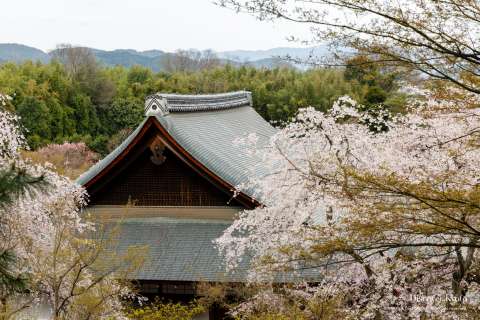
Tenryū-ji temple in Arashiyama is a destination that is usually already on everyone's list, but cherry blossom season adds a new element to enjoy. The Hyakka'en (Garden of a Hundred Flowers) is home to a variety of flowering plants, and that includes the popular sakura. Take a stroll along the famous Sōgen Pond and head deeper into the spacious grounds to find several varieties of cherry trees dotting the landscape. Our recommended spot is from the top of the hill the Hyakka'en sprawls over, which provides for a nice view of the temple roofs and sakura blossoms.
Arashiyama

You may be in Arashiyama to visit the many temples in the area, but you can actually see a variety of cherry blossoms for free along the Hozugawa River and from the popular Togetsu-kyō Bridge. The mountains of Arashiyama are dotted with pink flowers in spring, and the contrast with the fresh green makes for a lovely view.
If you're interested in a view from above, check out Senkō-ji temple or Ōkōchi Sansō, which both offer breathtaking sights of the Arashiyama scenery.
Daikaku-ji

Daikaku-ji, a lovely temple in Arashiyama, is popular in sakura season for the ring of blooming trees that grow on the banks of the sizable Osawa Pond. Before you begin the leisurely pond stroll, check around the temple's main buildings for several sakura trees as well, particularly by the chokushi-mon (imperial envoy gate).
If you are visiting in mid-April, you can also enjoy the Kadō Matsuri, a festival that features ikebana flower arrangements and bugaku dance at Daikaku-ji.
Daigo-ji
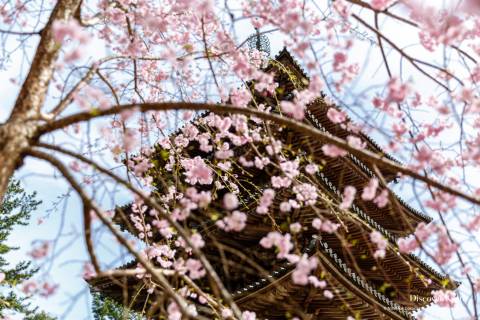
This UNESCO World Heritage Site temple is famous in fall and spring, with visitors flocking in to view the cherry blossoms at both the main temple and its sub-temple Sanbō-in. In 1598, Toyotomi Hideyoshi held a grand cherry blossom viewing party at Daigo-ji, and in preparation for the occasion had 700 cherry trees brought in and planted at the premises. Lining the path from the temple entrance to its grand gate, they make the approach to Daigo-ji breathtaking in spring, and exploring the expansive grounds will yield a wide variety of sakura species in a range of displays.
Kajū-ji

A small temple in Kyoto's southeastern Yamashina area, Kajū-ji is a charming place to go and escape the inner city crowds that swell during this popular tourist season. The temple's Himuro Pond is a well-known spot for birdwatching and seasonal flowers like lotus, iris, and lilies, and there are also sakura trees planted along the pond and the Kannon Hall. You'll know you're on the right path to the gate when you find the white temple outer walls and the street lined with young weeping cherries.
Gallery
-




 +46
+46
